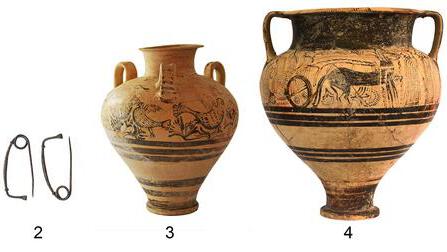“We found large quantities of imported pottery at Hala Sultan Tekke, as well as luxury items made of gold, silver, ivory and semi-precious stones, showing that the city’s copper production was a coveted commodity,” says Peter Fischer, professor emeritus at the university’s history department Gothenburg and head of the excavations.
The Swedish Cyprus Expedition is a project that has been running since 1927 to research the archaeological history of the island. The most recent expedition led by Peter Fischer in Hala Sultan Tekke, near today’s city of Larnaca on the southern coast of Cyprus, started in 2010 – since then 13 campaigns have been carried out. The excavations showed that the city covered at least 25 hectares, of which 14 hectares was the walled city centre. During the investigations, Late Bronze Age objects were also discovered in the wider vicinity of the settlement.
“Our investigations and excavations show that Hala Sultan Tekke was larger than previously thought, covering an area of 25 to 50 hectares, which was a large city for the time. At that time and in this region, settlements were normally only a few hectares in size,” says Peter Fischer.
Largest copper producer
During the Bronze Age, Cyprus was the largest copper producer in the Mediterranean. The metal alloyed with tin formed the basis for the manufacture of bronze, from which tools, weapons and jewelry were cast before iron was used.
“The remains in the city show extensive copper production in the form of furnaces, molds, and slags. The ore from which the copper was extracted was brought to the city from mines in the nearby Troodos Mountains. The workshops produced a lot of soot and were located to the north of the city, so the winds, which were mainly from the south, blew the soot and stench out of the city. This type of production would be impossible today because waste products such as arsenic, lead and cadmium are produced during production, but at the time no one knew how dangerous the process was,” says Peter Fischer.
Large amounts of imported goods
The central location of Cyprus in the eastern Mediterranean and a well-protected port created very favorable conditions for lively trade in Hala Sultan Tekke. Large amounts of imported goods in the form of pottery, jewelery and other luxury goods have been found from neighboring regions such as what is now Greece, Turkey, the Middle East and Egypt, as well as long-distance imports from Sardinia, the Baltic Sea region, Afghanistan and India. These finds prove that the city was inhabited in the period from 1500 to 1150 BC. was one of the largest trading hubs and was of great importance in the early days of international trade in this area.
In addition to copper, the coveted purple-colored textiles were also produced. The dye came from purple Murex species, from whose slime the purple dye was obtained. The city also produced and exported pottery with distinctive painted motifs of people, animals, and plants. The researchers refer to the artist who painted these motifs as the “Hala Sultan Tekke painter”.
»The beauty of the many ceramic finds is that we can help our colleagues around the Mediterranean and beyond. No pottery is as widespread as the coveted Cypriot pottery of this period. By finding locally made pottery that we can date to the same stratum as other imported pottery that has previously been difficult to date, we can compare them and help colleagues date their finds,” says Peter Fischer.
500 years of flourishing trade
The name of the Bronze Age city goes back to the fact that the expedition initially named the place after the Hala Sultan Tekke mosque, which now stands near the excavation site. Trade thrived in the city for nearly 500 years, but like some other Bronze Age civilizations around the Mediterranean, Hala Sultan Tekke collapsed shortly after 1200 BC. together. The prevailing hypothesis was that at this time “Sea Peoples” invaded the eastern Mediterranean, destroying cities and putting an end to Bronze Age civilizations.
“It used to be thought that the Sea Peoples were the only explanation. Our research over the past few years has nuanced this explanation. There are now new interpretations of written sources from this period in Anatolia (today’s Turkey), Syria and Egypt, which report on epidemics, famines, revolutions and acts of war by invading peoples. Our research also suggests that worsening climate played a role. All of this may have had a domino effect, with people moving south-east from the central Mediterranean in search of better living conditions, coming into conflict with the cultures of present-day Greece, Cyprus and Egypt,” Peter Fischer concludes.
